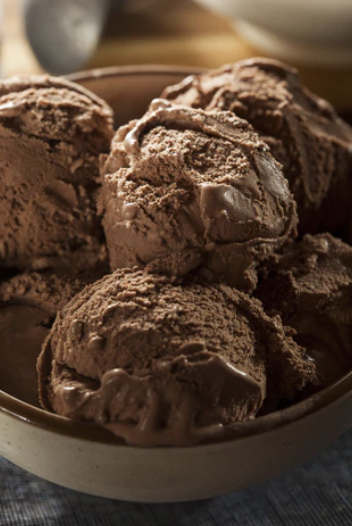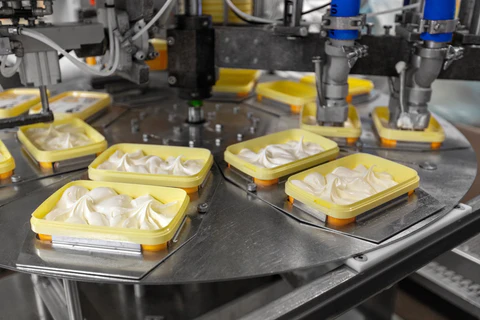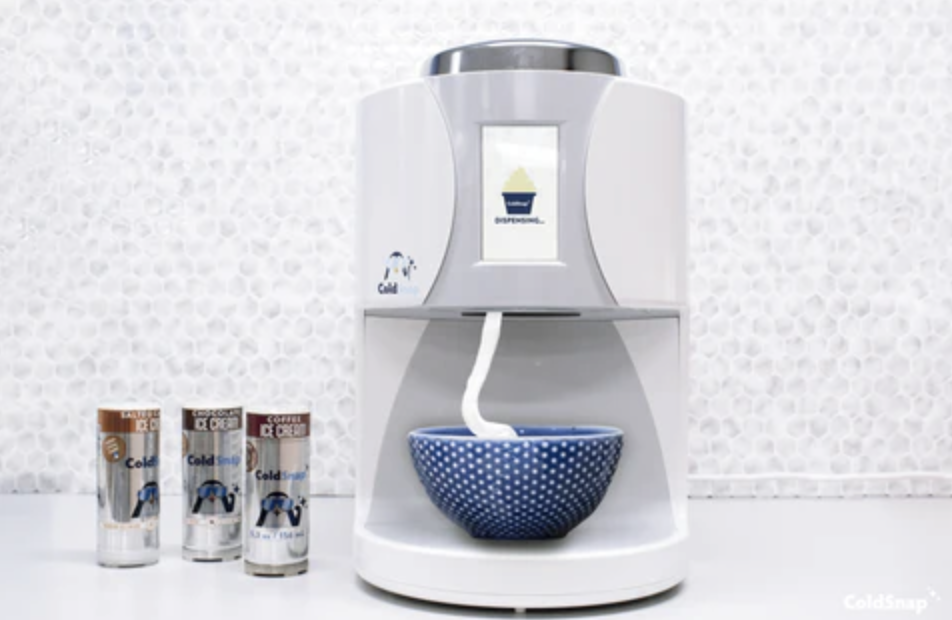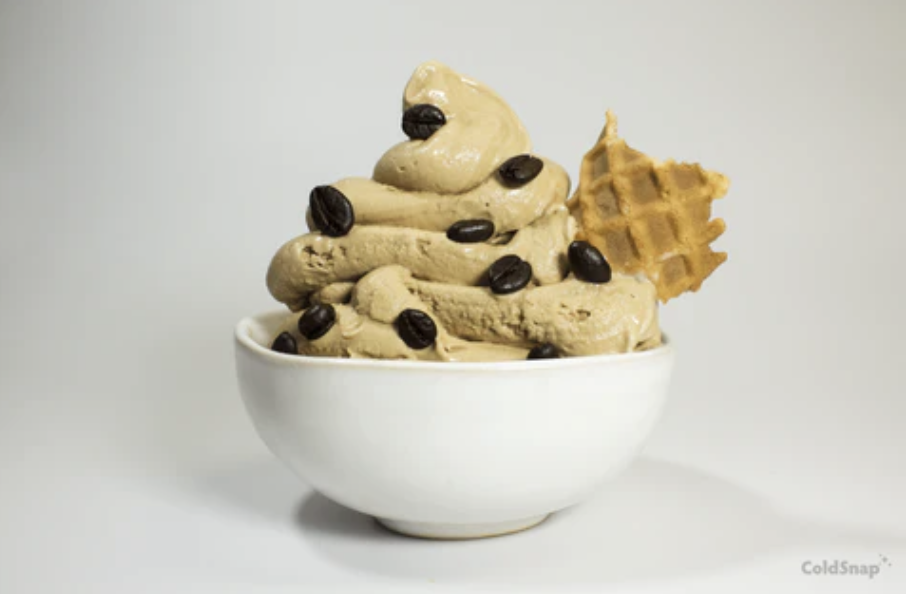Strolling through the grocery store, you push your cart through the frozen dessert aisle, tossing in a pint of your favorite ice cream. You check out, drive ten minutes home and shove your treasured treat into the freezer – phew! It didn’t melt yet! You dig into the delicious bowl of ice cream later that night, just like so many other nights, blissfully unaware of the frozen journey your Chunky Monkey has taken to reach you.
While you polish off your pint (it’s been a long day!), more ice cream is in process, getting ready to take the trip that your ice cream just went on. The journey of traditionally-made frozen confections is chilly and energy-intensive. Let’s go along for the ride to see how ice cream gets from manufacture to the frozen desserts section of the grocery store, and how ColdSnap saves on carbon emissions with its innovative ice cream maker (that also rapid-freezes other frozen confections).

Decreasing Ice Cream’s Carbon Footprint with ColdSnap’s On-Demand Freezing Technology
Manufacturers are aware of the carbon footprint associated with making ice cream, and some are working toward more sustainable solutions. Ben & Jerry’s estimates that each pint of ice cream they make produces about 3.3 pounds of greenhouse gases. Unilever, the owner of Ben & Jerry’s, has committed to reducing the greenhouse gas emissions associated with its ice cream production by 45% by 2030. Circumventing the cold chain with ColdSnap’s technology is one way to help the world’s largest ice cream manufacturer achieve this goal.
What is the Cold Chain?
The “cold chain” describes a temperature-controlled supply chain. For frozen confections to arrive to consumers in top condition, products must be kept below a certain temperature at every stage of the journey. While the cold chain is important for all perishable products, from fruits and vegetables to candy, with ice cream it is absolutely critical.
To maintain adequate cold temperatures along the supply chain, there are many logistical details to coordinate: refrigerated packaging and intricate planning to minimize transit times being two of them. It takes a lot of energy to keep products at optimal chilliness, and this, of course, means increased carbon emissions. It is estimated that the global cold supply chain accounts for approximately 1% of carbon emissions.
The Energy Required to Keep Ice Cream Cold
Let’s consider the journey of ice cream you’d find in the grocery store. No matter what your favorite pint is, they all go through the same general process. We’ll start from the ice cream manufacturing facility.
After milk and cream are combined with dry ingredients, the mix is pasteurized, homogenized, and aged before it is frozen. In this step, it is frozen to a soft-serve consistency by freezers set to around 20F, at which point fruit and other bulky flavorings are added. The ice cream is soft and easy to mix at this stage, so flavorings can be uniformly distributed throughout the ice cream.

It is then packaged into cartons and hardened to a temperature of less than -13F. It takes two to three hours for a chilled tunnel and ceiling fans to make the ice cream rock solid. The cartons are then transported by refrigerated truck and stored in a refrigerated warehouse, where they can be kept in deep freezers for one to two years.
During distribution, ice cream must be kept below -13F. This helps prevent temperature fluctuations that can adversely affect the quality of ice cream, especially its texture. If you’ve ever eaten freezer-burned ice cream, you have an understanding of what happens when ice cream thaws and then refreezes. Not ideal. Eventually, the ice cream is shipped to retailers and kept in walk-in freezers before it makes its debut in the frozen aisle.

Making ice cream and moving it around requires a lot of logistical coordination and energy! Who would have thought that transporting our favorite frozen treat was so involved?
How ColdSnap Circumvents the Cold Chain and Saves On Carbon Emissions

ColdSnap uses the same ingredients as any other ice cream manufacturer – milk, cream, sugar, and flavorings. After the ColdSnap ingredients are combined into a liquid mix, they are heated and homogenized, similar to other ice cream production facilities. The rest of the ice cream journey, however, is different. So different, in fact, that it is not an exaggeration to say that ColdSnap is revolutionizing the frozen confections industry.
After the ColdSnap ice cream mix is prepared, pods (the size of Red Bull cans) are filled with liquid ice cream mix, hermetically sealed, and briefly heated, making them shelf-stable. From this point on, the pods are stored at room temperature, ready to be flash-frozen in one of ColdSnap’s rapid freezing appliances when the craving for a creamy frozen treat hits. On-demand freezing of products stored at room temperature has long been an elusive goal in the frozen confections world, but ColdSnap has figured out how to do it. ColdSnap’s freeze-on-demand technology has the potential to significantly decrease the carbon emissions associated with making delicious, premium ice cream and other frozen treats!
Curious as to the extent that ColdSnap’s patented technology could decrease carbon emissions, we engaged the sustainability consultancy CoClear. In 2021, CoClear performed a product life cycle assessment to estimate the carbon emissions of ColdSnap’s technology, and compare it to the emissions of a traditional, US-based ice cream manufacturer.
Carbon emissions associated with ingredients were set aside since these are the same as in other frozen desserts. The CoClear study found that ColdSnap’s revolutionary technology reduces carbon emissions for all other stages of the product life cycle between 30% and 35%. The most significant savings in carbon emissions come from circumventing the cold chain, which decreases the energy required during manufacturing, packaging, transporting, warehousing, and retailing. Additional energy savings come from recycling the aluminum ColdSnap pods.
There are many advantages to freezing ice cream and other frozen treats on demand. Ice cream is extremely sensitive to temperature fluctuations, so eliminating the cold chain and freezing on demand helps produce a consistent and decadently smooth product every time.
Another huge advantage, though, is undoubtedly the carbon savings. ColdSnap looks forward to conducting additional studies on the impact of our technology on carbon emissions as we move into our broader commercial launch.

By Lyn Ferreira
ColdSnap photos by Allyson Preble
Get the Scoop
Stay in the loop on all things ColdSnap with our newsletter.
Categories
Recent Posts
- ColdSnap Partners With Foodbuy to Deliver On-Demand Frozen Treats to Foodservice Operators
- Your Morning Just Got a Whole Lot Smoother: How to Make a Delicious & Healthy Smoothie with ColdSnap
- 7 Reasons Every Golf Course Needs a ColdSnap Machine
- Empowering Students with Self-Serve Frozen Treats — No Hassle, All Joy
- Ice Cream on Demand…From a Can??


